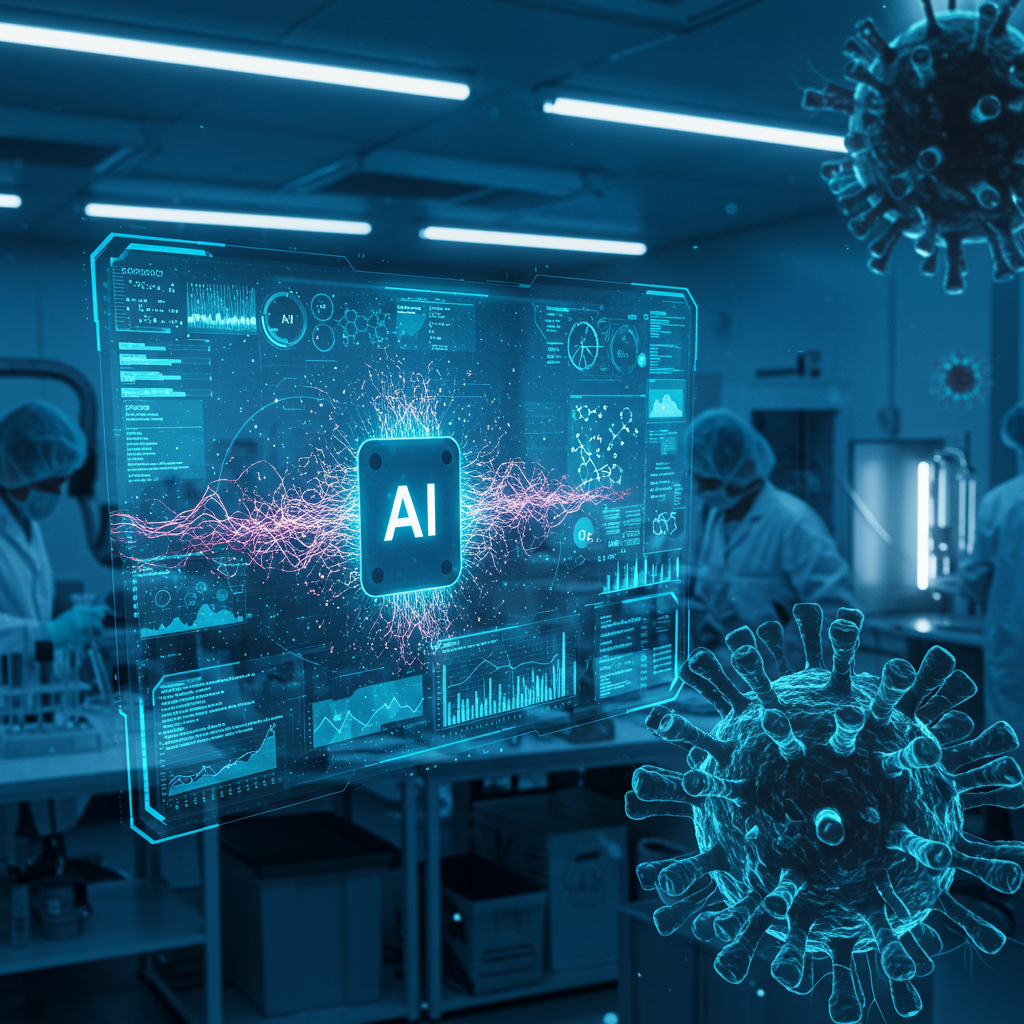The world faces a silent, escalating crisis: antimicrobial resistance (AMR). Drug-resistant “superbugs” are rendering our most vital antibiotics ineffective, claiming millions of lives annually and threatening to dismantle modern medicine as we know it. But a revolutionary ally has emerged in this urgent battle: Generative AI. This cutting-edge technology isn’t just accelerating drug discovery; it’s reimagining how we create life-saving medicines from the ground up, offering a much-needed beacon of hope against a looming global health catastrophe.
The Alarming Rise of Antimicrobial Resistance
Imagine a future where common infections become deadly, routine surgeries are too risky, and even a simple cut could be fatal. This isn’t science fiction; it’s the stark reality presented by the unchecked spread of antimicrobial resistance. Reports indicate that AMR is already responsible for over a million deaths each year, with projections reaching nearly 40 million by 2050 if left unaddressed. In the United States alone, over 2.8 million drug-resistant infections occur annually. The problem worsened during the COVID-19 pandemic, with a significant increase in hospital-acquired infections from formidable pathogens like Carbapenem-resistant Enterobacterales and multidrug-resistant Pseudomonas aeruginosa. The traditional pipeline for new antibiotics has faltered, leaving humanity vulnerable as bacteria rapidly evolve.
Generative AI: Designing New Antibiotics from Scratch
For decades, antibiotic discovery relied on screening vast libraries of existing chemical compounds. This approach, while fruitful in the past, has largely dried up. Generative AI changes the game entirely. Instead of simply finding hidden gems, these intelligent algorithms are now capable of designing entirely novel molecular structures that have never existed before. This represents a fundamental shift from using AI as a “discovery tool” to harnessing it as a powerful “design tool.”
Pioneering this paradigm shift is research from institutions like MIT. Led by Professor Jim Collins, a team has trained generative AI models using sophisticated neural networks. These models analyze millions of chemical fragments, assembling them into complete molecular structures. Critically, a second algorithm then predicts which of these newly designed structures will possess the strongest antibacterial efficacy. This groundbreaking process can yield over 10 million candidate molecules, all de novo.
Unveiling Novel Mechanisms of Action
Early successes with AI, such as the discovery of halicin (a broad-spectrum agent) and abaucin (effective against Acinetobacter baumannii), and a new class against MRSA and VRE, were achieved by screening existing compounds. The latest breakthrough from Collins’s team, published in Cell, moves beyond this. From millions of AI-generated possibilities, researchers manually filtered for “drug-likeness” and synthetic feasibility, narrowing down to about 200 promising designs. Of these, 24 were successfully synthesized in the lab, and seven proved to be potent antimicrobial agents in lab tests.
Remarkably, two of these showed strong efficacy in mouse models against drug-resistant Neisseria gonorrhoeae and Staphylococcus aureus. A crucial insight is that each of these seven active compounds appears to work through a distinct and novel mechanism of action, a significant advantage given that existing antibiotics often share similar mechanisms, making resistance easier to develop.
From AI Design to Lab Synthesis: The Practical Challenge
While generative AI excels at conceptualizing millions of potential drugs, a significant “bottleneck” has been the challenge of actually synthesizing these complex molecules in a lab. Many AI-generated designs, though theoretically perfect, are incredibly difficult or expensive to manufacture. This highlights the multi-objective optimization problem in drug design: balancing sheer biochemical possibility with crucial metrics like potency, safety, low toxicity, and, crucially, ease of synthesis.
To address this, researchers at McMaster University and Stanford University developed SyntheMol. This generative AI tool specifically designs antibiotic candidates with chemical blueprints explicitly tailored for real-world manufacturing. Unlike some models that explore vast, almost infinite chemical spaces, SyntheMol operates within a more constrained space of tens of billions of molecules. It achieves this by selecting only those building blocks that can be synthesized using known, lab-proven reaction steps.
Published in Nature Machine Intelligence in March 2024, SyntheMol has already demonstrated its power by identifying six distinct, non-toxic molecules with potent antibacterial activity against Acinetobacter baumannii, a “most dangerous” pathogen according to the WHO. A major “game changer” is that SyntheMol not only generates promising candidates but also provides the explicit “recipe” for their creation, drastically accelerating the path from design to the chemist’s bench.
Phage Therapy: An Evolving AI-Driven Solution
Beyond small-molecule antibiotics, Generative AI is also revitalizing another promising antimicrobial approach: phage therapy. Phages are natural, self-replicating viruses that specifically target and destroy bacteria, acting like precision missiles rather than broad-spectrum “bombs” that wipe out beneficial bacteria too. A key advantage of phages is their ability to evolve alongside bacteria, constantly adapting to overcome bacterial resistance – a capability man-made antibiotics lack.
French biotech startup Phagos, leveraging artificial intelligence on Amazon Web Services (AWS), is at the forefront of this innovation. Historically, matching the right phage to a specific bacterial infection was a painstaking, unscalable trial-and-error process, given the estimated 10^31 phage particles on Earth. Phagos is revolutionizing this by using generative AI to predict effective phage-bacteria matches by “reading into the DNA.” Their AI platform analyzes vast training data, moving beyond manual screening to rapidly and accurately identify suitable phages.
Phagos’s collaboration with AWS, particularly through the 2024 AWS Generative AI Accelerator Program, has provided vital cloud credits, mentorship, and technical support. This has significantly accelerated their infrastructure development and model optimization. While human health is their long-term ambition (targeting 2030), Phagos is currently focused on animal health, where the majority of antibiotics are used, contributing significantly to resistance in the environment. Their early success in an oyster farm in France, achieving a 40% reduction in mortality, proves the concept’s potential. Phagos aims for personalized, adaptive, and scalable phage therapy, continuously improving their platform with each new phage cocktail delivered.
The Economic “Valley of Death” and Policy Solutions
Even with the astounding efficiency gains offered by Generative AI in drug discovery, a significant hurdle remains: the “uniquely broken economic ecosystem” for antibiotics. Developing any new medicine is a decade-long, multi-billion-dollar endeavor. However, antibiotics face a “second valley of death” unique to their market. To prevent resistance, their widespread use is discouraged, limiting sales volume. New brands also face pricing pressure from existing, low-cost generics. This means companies often cannot recoup their development costs. Since 2017, nearly all small companies that gained FDA approval for a new antibiotic have faced bankruptcy or acquisition, and crucially, none of these new treatments represented a novel class of antibiotics with new mechanisms of action.
This economic reality threatens to undermine even the most brilliant AI-driven scientific breakthroughs. This is where sound public policy becomes indispensable. The proposed US PASTEUR Act, for example, offers a promising solution: a subscription-style model where the government contracts with biotech companies, providing predictable annual payments for access to new antibiotics. This innovative approach decouples financial success from sales volume, creating the necessary economic incentives for continued research and development. The United Kingdom has successfully piloted a similar model since 2019, making it permanent in May 2023, with Japan and Canada also exploring comparable initiatives.
Frequently Asked Questions
What is Generative AI doing differently in the fight against superbugs?
Generative AI marks a profound shift in antibiotic discovery. Historically, AI was used as a “discovery tool” to identify promising compounds from existing chemical libraries. Now, Generative AI acts as a “design tool.” It creates entirely new molecular structures from scratch, predicting their antibacterial efficacy and even providing “recipes” for their synthesis. This allows for the development of novel classes of antibiotics with distinct mechanisms of action, crucial for bypassing existing bacterial resistance.
Are AI-designed drugs currently undergoing human trials, or are they still in early development?
While Generative AI has successfully designed numerous promising antimicrobial compounds that have shown efficacy in lab tests and animal models (like mice), most are still in preclinical or early-stage development. Organizations like Phare Bio, a non-profit founded by MIT’s Jim Collins and backed by the U.S. government’s ARPA-H and Google, are actively working to move their most promising AI-designed antibiotic candidates into human trials. The journey from discovery to clinical approval is long, typically taking a decade or more, even with AI’s accelerated initial steps.
Why is it so challenging to bring new antibiotics to market, even with advanced AI-driven discovery?
The primary challenge is an “uniquely broken economic ecosystem” for antibiotics. Unlike other drugs, new antibiotics are often reserved for critical cases to prevent resistance, limiting their sales volume. This, combined with competition from cheap generics, makes it nearly impossible for companies to recoup the multi-billion-dollar development costs. This “second valley of death” means that even with AI accelerating discovery and reducing initial costs, companies lack the financial incentive to bring new, resistance-fighting drugs to market. Public policy interventions, such as “subscription models” like the proposed US PASTEUR Act, are essential to create sustainable economic incentives.
A Collaborative Future Against AMR
Defeating the global threat of antimicrobial resistance requires a multifaceted, collaborative effort. Generative AI offers an unparalleled scientific tool, accelerating drug discovery and designing novel solutions. However, its full potential can only be realized when coupled with innovative public policies that address the economic hurdles unique to antibiotic development. By combining cutting-edge AI, pioneering academic research from institutions like MIT and McMaster, and forward-thinking government initiatives, humanity stands a far greater chance of outpacing resistance and securing a future where life-saving antibiotics remain effective.




